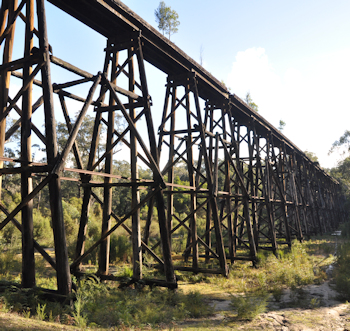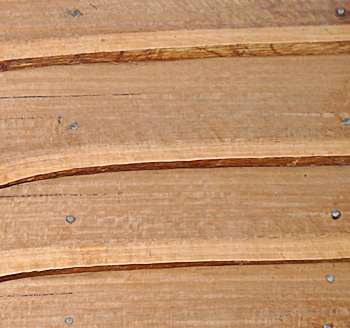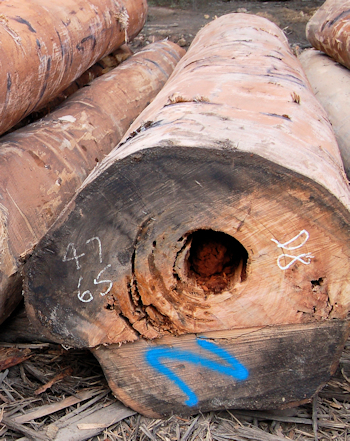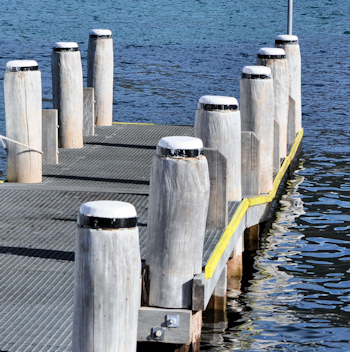Durability

built in 1916 from grey box and red ironbark
and still standing today, over 100 years later
The durability of a species of timber is its ability to resist attack from fungal decay and insects.
Some timbers are naturally more resistant to attack than others because of their structure and chemical make-up.
The wood tissue that’s most durable is in the heartwood region of the log, since this is where the waste products and other extractives are deposited while the tree is growing.
Extractives are chemical compounds that can be extracted from the wood using solvents, such as water or alcohol.

showing the lighter-coloured sapwood
and darker-coloured heartwood
in each board
They include tannins and resins produced by the tree and various minerals absorbed through the root system.
Although extractives aren’t an essential part of the wood fibres’ structure (which is made up of cellulose, hemicellulose and lignin) they do determine the colour of the wood and its oiliness. They can also have an effect on how easy the timber is to work with when it’s being machined or cut.
In general, hardwood species tend to be more durable than softwoods because they contain extractives that are more toxic to fungi and some insects. It’s also often the case that darker coloured timbers will have higher levels of extractives than lighter-coloured timbers.
Nonetheless, there are some exceptions to these rules of thumb. For example, some softwood species are used in outdoor applications because they’re known for their natural durability – such as western red cedar and cypress pine. By the same token, there are various hardwood species that have very low durability – such as meranti, oak and beech.
The sapwood region of all timber species is considered non-durable. This is because it contains much higher quantities of sugars and starches, and much lower levels of other extractives. The sugars and starches are the tree’s food supply, and also the food source of some of the organisms that are likely to attack the wood fibres.
However, although the sapwood region is less durable to start with, it’s also the easiest to treat with preservative chemicals. This is because the chemicals are able to penetrate well into the cell cavities, unlike in the heartwood where the cavities are blocked with tannins, resins and other extractives.
In addition, some softwoods – particularly radiata pine – have a wide band of sapwood that provides an excellent envelope of protection when the treatment chemicals are forced into the timber under pressure. We’ll talk more about preservative chemicals and treatment techniques in other sections.
Durability ratings
There are various reference documents that publish the durability ratings for a range of timber species – that is, the durability of the timber in its natural state without the protection of preservative chemicals or surface coatings. Sometimes different reference sources give different ratings to particular species, since there are so many variables to consider when deciding on an overall ranking system.
Some of the factors that need to be taken into account when researchers determine the rating for a species include:

eaten out by a combination of termites and fungal decay
-
the variability of attacking organisms in different regions and localities – for example, some species of termites are far more destructive to wood fibres than others, but their distribution will vary greatly throughout Australia depending on the climate and environmental conditions
-
the ability of particular timber species to be very resistant to some types of attack but less so to others – for example, brush box is highly resistant to termite attack because of the silica content in its fibres (which is abrasive to the termites’ jaws), but quite susceptible to fungal decay
-
the variation in durability between different trees of the same species, and between different parts of the same tree – for example, although the heartwood region contains toxic extractives that help to protect it from attack, the concentration of toxins tends to decrease in cells closer to the centre of the tree (in and around the pith), which is why fungal decay often eats out a central pipe
-
the availability of comprehensive research data for the timber species being rated – some species have extensive data available that dates back many years and covers a wide range of different conditions, while other species only have limited or short-term data available.
Australian standards
One of the main authoritative reference sources in Australia is AS 5604: Timber—Natural durability ratings. This Australian Standard lists many commercially-used hardwoods and softwoods, and ranks them in terms of their natural resistance to attack from the following types of organisms:
-
Lyctid borers (also called powder post beetles) – rating the sapwood as either ‘susceptible’ (S) or ‘not susceptible’ (NS); note that lyctid borers do not attack the heartwood of any timber species.
-
Termites – rating the heartwood as either ‘resistant’ (R) or ‘not resistant’ (NR).
-
Organisms in general, including decay fungi and insects – rating the heartwood in terms of its average ‘in-ground’ life expectancy and ‘above-ground’ life expectancy (see below for the table of durability classes).
-
Marine borers – rating the heartwood in terms of its average life expectancy when used as a marine pile in Australia’s southern waters (see below for the table).
The table below shows the four ‘natural durability’ classes. You can see that timber used above ground generally lasts a lot longer than timber in direct contact with the ground. This is because ground contact allows moisture to be constantly absorbed through the wood fibres, making them more susceptible to fungal decay. It also provides direct access to subterranean (underground) termites.
| Natural durability of heartwood | ||
| Durability Class | Probable in-ground life expectancy (in years) |
Probable outside above-ground life expectancy (in years) |
| 1 | Greater than 25 | Greater than 40 |
| 2 | 15 to 25 | 15 to 40 |
| 3 | 5 to 15 | 7 to 15 |
| 4 | 0 to 5 | 0 to 7 |
Marine borer resistance is rated in a separate table, because marine piles are subject to extreme conditions and there are very few timber species that are suitable for use.

The table below shows the four durability classes for marine piles in southern waters (south of Perth in the west and south of Batemans Bay in the east). Where a marine pile is used north of these locations, only Class 1 timbers are suitable, and even then their life expectancy is greatly reduced (expected to be an average of 12 to 30 years).
| Marine borer resistance in southern Australian waters | |
| Class | Probable life expectancy (in years) |
| 1 | Greater than 60 |
| 2 | 41 to 60 |
| 3 | 21 to 40 |
| 4 | 0 to 20 – usually less than 5 |
Natural durability ratings of various species
Below are some examples of the natural durability ratings of the heartwood in various commonly used building timbers. These ratings are taken from AS 5604.
| Natural durability class of heartwood | ||
| Timber species | In ground contact | Outside above ground |
| Alpine ash (Eucalyptus delegatensis) | 4 | 3 |
| Blackbutt (Eucalyptus pilularis) | 2 | 1 |
| Brush box (Lophostemon confertus) | 3 | 3 |
| Douglas fir (oregon) (Pseudotsuga menziesii) | 4 | 4 |
| Grey box (Eucalyptus macrocarpa) | 1 | 1 |
| Grey gum (Eucalyptus punctata) | 1 | 1 |
| Grey ironbark (Eucalyptus paniculata) | 1 | 1 |
| Hoop pine (Araucaria cunninghamii) | 4 | 4 |
| Jarrah (Eucalyptus marginata) | 2 | 2 |
| Karri (Eucalyptus diversicolor) | 3 | 2 |
| Light red meranti (Shorea spp.) | 4 | 4 |
| Merbau (Intsia bijuga) | 3 | 1 |
| Radiata pine (Pinus radiata) | 4 | 4 |
| Red ironbark (Eucalyptus sideroxylon) | 1 | 1 |
| River red gum (Eucalyptus camaldulensis) | 2 | 1 |
| Silvertop stringybark (Eucalyptus laevopinea) | 3 | 3 |
| Slash pine (Pinus elliottii) | 4 | 4 |
| Spotted gum (Corymbia maculata) | 2 | 1 |
| Sydney blue gum (Eucalyptus saligna) | 3 | 2 |
| Tallowwood (Eucalyptus microcorys) | 1 | 1 |
| Turpentine (Syncarpia glomulifera) | 2 | 1 |
| Western red cedar (Thuja plicata) | 3 | 2 |
| White cypress (Callitris glaucophylla) | 2 | 1 |
| Yellow stringybark (Eucalyptus muelleriana) | 3 | 2 |